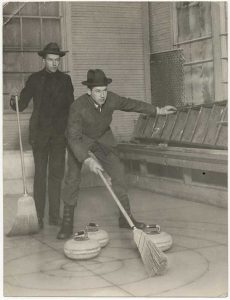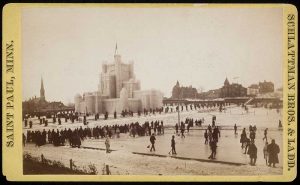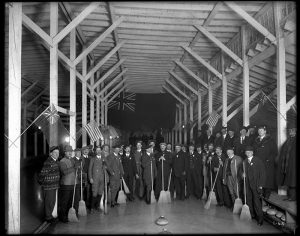Small Home Gazette, Winter 2018
Curling in the Bungalow Era
Watching the Winter Olympics you can’t help but be drawn to curling. After wowing at the giant slalom snowboarders and holding your breath with the biathletes, you see the curlers. For the first time while cheering on the winter athletes from your cozy armchair, you think, “Maybe I could be an Olympian.”

Curlers striking defensive position, 1925. Image used with permission of the Minnesota Historical Society.
Compared to the speed skaters or bobsledders, curlers don’t look so buff. Don’t be fooled. Curlers need to balance themselves in a lunge while sliding down the ice and “toss” (push) granite stones (also called rocks) weighing 38 to 44 pounds down a 150-foot sheet of ice. Some curlers use a backswing delivery that lifts the heavy stone into the air prior to forward release. When sweeping a broom in front of the stone to help direct it and extend its distance traveled, curlers get an intense cardio workout. In a typical game, curlers will walk two miles or more.
What Is Curling?
Curling looks something like playing shuffleboard and scores like bocce ball. Alternating play, two teams compete to have as many of their stones closer to the center of the “house” (target) than the opponent. Curling has been referred to as “chess on ice” for its strategy and compared to golf because curlers must read the ice just as golfers read the greens and finesse their shots.
Originally played outdoors, the sport began in Scotland in the early 1500s. The game is said to have spread in the 19th century wherever the Scottish settled around the world in cold climates, including across Canada to the Minnesota territory. The first curling club in America is believed to have been established in the 1830s near Detroit.
Minnesota History

Curling in front of the 1886 St. Paul Winter Carnival ice palace. Organizers were eager to showcase the beauty of Minnesota winters in response to a New York-based newspaper correspondent who described St. Paul in wintertime as “another Siberia, unfit for human habitation.” Our version of Siberia looks so pleasant with civilized curlers playing in front of a frozen palace. Image used with permission of the Minnesota Historical Society.
Historic photos show games being played in 1893 on the frozen Mississippi River for the first-ever Northwestern Curling Association bonspiel (curling tournament). Curling was one of the activities promoted at the first St. Paul Winter Carnival in 1886.
In the Arts & Crafts era, curling grew in popularity as leisure time became more common. Several curling clubs existed in Minneapolis and St. Paul in the early 1900s, many with buildings to shelter players and spectators. With passing years and buildings needing repairs, many curling clubs folded. In 1912, the Capitol City Curling Club and Nushka Club merged to form the St. Paul Curling Club and open a new clubhouse on Selby Avenue, where it still operates. Today there are five local clubs and players of all skills are invited to participate.
Join In

Capitol City Curling Club, 1910. Notice something missing from these historic photos? Although women curled in Canada and other parts of the Upper Midwest for decades, in St. Paul, they were only able to participate in curling events on rare occasions until 1952 when a women’s curling league was started. Image used with permission of the Minnesota Historical Society.
Stop by one of the local clubs to watch the “roaring game,” so called because of the sound made by a granite stone as it moves down the ice. Ask someone to explain the game or try your hand at the sport by signing up for a learn-to-curl class. There is an etiquette to learn. Before a team steps out onto the ice, give them a nod, or handshakes if you are playing against them, and say “good curling.”
Watch or play a game at one of the Twin Cities curling clubs:
- St. Paul Curling Club
- Chaska Curling Center
- Dakota Curling Club, Lakeville
- Four Seasons Curling Club, Blaine
- Frogtown Curling Club, St. Paul
Resources
This article contains information gleaned from the 2012 book, 100 Roaring Years on Selby Avenue: The St. Paul Curling Club, written by members of the St. Paul Curling Club and published by Beaver’s Pond Press. (Out of print; used copies may be available online.)
Learn more about curling: https://worldcurling.org/about/curling/











